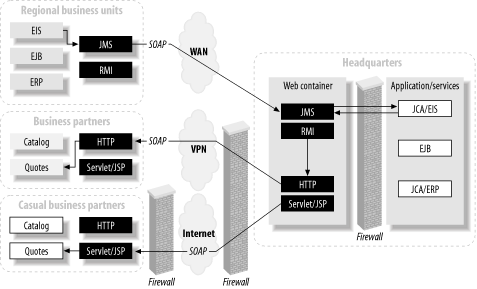A common thread found throughout various web services specifications is the regular reference to web services “platforms” and “providers.” A web services platform is an environment used to host one or more web services. It includes one or more SOAP servers, zero or more UDDI business registries, the security and transaction services used by the web services hosted on it, and other infrastructure provisions. A web services provider is generally considered a vendor-supplied piece of middleware infrastructure, such as an ORB, an application server, or a MOM. The provider may fully supply a platform, or it may deliver some base J2EE functionality plus some web service add-ons.
Web services are a new approach for exposing and advertising enterprise services that are hosted on a platform. These platform services still have a variety of enterprise requirements, such as security, transactions, pooling, clustering, and batch processing. Web services do not provide these infrastructure capabilities, but expose the services that do. J2EE and .NET still play an important role in the enterprise as platform definitions: they define the behavior of core capabilities that every software program needs internally. Web services, however, offer a standard way to expose the services deployed onto a platform.
An important question is, “What is being web service enabled?” If the answer is the business systems that run the enterprise, then the role of J2EE in the whole web services picture becomes abundantly clear. The core requirements of a web service enabled ecosystem are the same as they have always been—scalability, reliability, security, etc. Web services provide new ways of wrapping things at the edge of the enterprise, but if you poke your head through the web services hype, the requirements for holding together your core systems don’t change that much. The implemention of the web services backbone should still be based on the J2EE architecture. Web services and J2EE come together at multiple points. The use of each J2EE component depends on the application’s requirements, just as it did prior to the advent of web services. If the nature of the web service is for lightweight, quick-and-dirty processing, then use a web container and implement the web service directly as a JSP. If the solution requires a distributed component model, then use EJB. If the solution requires a highly distributed, highly reliable, loosely coupled environment, then use JMS. Naturally, any of these combinations is allowed and encouraged, as illustrated in Figure 1-4.
Get Java Web Services now with the O’Reilly learning platform.
O’Reilly members experience books, live events, courses curated by job role, and more from O’Reilly and nearly 200 top publishers.


